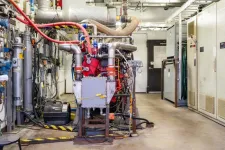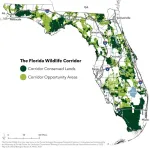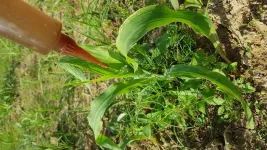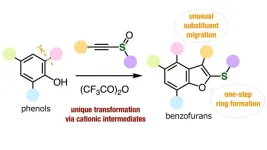(Press-News.org) SAN ANTONIO — August 16, 2024 —Southwest Research Institute helps the automotive industry transition to smart, sustainable mobility, developing hybrid, electric and hydrogen solutions and applying artificial intelligence for safe, eco-friendly driving. SwRI engineers will be in Detroit April 16-18 to share their expertise at the 2024 SAE International WCX™ World Congress Experience.
WCX invites mechanical, electrical and software engineers working in mobility from around the world to share new knowledge and advancements.
“The automotive and transportation sectors are going through tremendous change and challenges as they navigate the regulatory landscape and market demand in a push toward decarbonization. At the same time, automation, connected vehicles and artificial intelligence are creating exciting new possibilities,” said Daniel Stewart, vice president of SwRI’s Powertrain Engineering Division. “SwRI is proud to invest in research that explores hydrogen combustion engines, aftertreatment, low carbon fuels, fuel cells, motors, hybrids, battery system design and connected autonomous transportation systems that reduce emissions and pave the way for a sustainable world with less carbon in the atmosphere.”
SwRI experts will present publications, demonstrate projects and speak as panelists and moderators on various mobility topics. The following is a sampling of the technical sessions in which SwRI will participate.
Combustion & Propulsion
Dr. Qilong Lu, Powertrain Systems Engineering Department program manager, helped organize an April 17 session highlighting developments in ground propulsion technologies, including conventional and alternative vehicle propulsion systems.
Matthew Kubesh, Automotive Propulsion Systems Department research engineer, helped organize April 16-17 technical sessions covering advancements in vehicle fuel cell applications. Kubesh also co-chaired the Hybrid and Electric Propulsions Committee.
Sustainability & Emissions
Christopher Sharp, Institute engineer in the Commercial Vehicle Systems Department, will discuss the current state of the art in emissions control as part of an April 16 panel.
Svitlana Kroll, Commercial Vehicle Systems Department principal scientist, helped organize and will moderate an April 16 panel discussion on the challenges facing engine performance testing and mobile emission measurements as the industry transitions from fossil fuels to carbon-neutral fuels and electrification. Dr. Charles Roberts, an SAE Fellow and SwRI’s Commercial Vehicle Systems executive director, will participate as a panelist.
Dr. Graham Conway, Automotive Propulsion Systems Department staff engineer, co-chairs an April 18 session discussing efforts to characterize the total greenhouse gas emissions associated with the entire life cycle of a vehicle, including its manufacture, service life and recycling or disposal.
Connected & Automated Vehicles
Dr. Douglas Brooks, assistant director of SwRI’s Artificial Intelligence Department, will participate in an April 16 panel discussion about the possibilities and challenges of applying artificial intelligence to future vehicle and mobility applications.
Dr. Steve Dellenback, Intelligent Systems Division vice president, will moderate an April 16 panel discussion on the challenges original equipment manufacturers face in achieving Level 3 proficiency in automated driving systems.
Scott Hotz, Control Systems Department director, helped organize the April 17 session regarding the use of connectivity and automation to optimize powertrain operations.
Visit the SwRI-specific SAE International WCX™ World Congress Experience event page for more information, including a full list of topics to be covered at WCX: https://www.swri.org/event/sae-international-world-congress-experience-wcx.
For more information, visit https://sustainablemobility.swri.org.
END
SwRI to discuss automotive decarbonization, automation at SAE International’s WCX™ 2024
Engineers, mobility industry head to Detroit April 16-18 to discuss, explore mobility, technical challenges
2024-04-16
ELSE PRESS RELEASES FROM THIS DATE:
From a cryptic genetic element in the human gut to a sensitive biomarker
2024-04-16
A component of the human intestinal flora that has been little studied to date is the focus of a new study. Plasmids are small extrachromosomal genetic elements that frequently occur in bacterial cells and can influence microbial lifestyles – yet their diversity in natural habitats is poorly understood. An international team led by Prof. Dr. A. Murat Eren from the Helmholtz Institute for Functional Marine Biodiversity at the University of Oldenburg (HIFMB) reports in the science journal Cell, a mysterious plasmid, is one of the most numerous genetic elements in the human gut that could potentially serve as a powerful biomarker for identifying ...
Researchers can help shipowners achieve ambitious climate targets
2024-04-16
Shipowners around the world are in a very difficult position, because they are having to order new ships now that will run on fuel and technologies that are not yet fully developed.
A new study suggests that ammonia could be a smart and energy-efficient fuel in the race to achieve net zero in shipping. Researchers at the Department of Industrial Economics and Technology Management (IØT) and the Department of Marine Technology (IMT) at the Norwegian University of Science and Technology (NTNU) ...
Florida Wildlife Corridor eases worst impacts of climate change
2024-04-16
From rising temperatures and altered precipitation patterns to intense weather events such as hurricanes, Florida is experiencing significant climate-related challenges in tandem with skyrocketing insurance rates. As the state’s population continues to surge by 1,000 new residents a day, it is projected to lose 3.5 million acres of land to development by 2070, threatening Florida’s future ability to maintain biodiversity and ecosystem services.
A first-of-its-kind study highlights how Florida can buffer itself against both climate change ...
Creating an island paradise in a fusion reactor
2024-04-16
In their ongoing quest to develop a range of methods for managing plasma so it can be used to generate electricity in a process known as fusion, researchers at the U.S. Department of Energy’s (DOE) Princeton Plasma Physics Laboratory (PPPL) have shown how two old methods can be combined to provide greater flexibility.
While the two methods – known as electron cyclotron current drive (ECCD) and applying resonant magnetic perturbations (RMP) – have long been studied, this is the first time researchers have simulated how they can be used together to ...
Field-margin wetlands alone can’t fix the Gulf of Mexico’s dead zone
2024-04-16
Each summer, a hypoxic dead zone forms in the Gulf of Mexico, making some marine habitats unlivable. The dead zone is caused by nutrients—primarily from agricultural fertilizers—flowing into the Gulf from the Mississippi River. Restoring wetlands at field margins has been proposed to intercept some of the runoff, as wetland plants and soils are capable of absorbing nutrients like a living sponge. But estimates of nutrient removal by restored wetlands have varied widely. Shan Zuidema and colleagues took a whole-system approach to modeling the potential for wetlands to ameliorate the flow of nitrate to the ...
Research has lost none of its innovative drive
2024-04-16
A high-profile study made headlines in 2023 stating that the scientific and innovation system is producing less and less completely new knowledge. Researchers at the University of Basel are now refuting this claim, at least for patents: It is based on a measurement error.
The discovery of mRNA in the 1960s was groundbreaking. Suddenly there were completely new findings that ushered in new developments. This kind of discovery is described as “disruptive”. In contrast, research findings are “consolidating” when they build upon existing knowledge. They are also important, as the example of the ...
A nematode gel to protect crops in Africa and Asia
2024-04-16
The fall armyworm is a destructive corn pest, which recently arrived in Africa and Asia from the Americas and began causing major yield losses and increased use of insecticides, which pose environmental and human health risks. Entomopathogenic nematodes are soil-dwelling roundworms that can parasitize and kill fall armyworms with no risks to people or the environment, but application can be tricky because the nematodes are susceptible to desiccation and UV radiation from sunlight. Patrick Fallet and colleagues report success using an innocuous biodegradable ...
Breakthrough in benzofuran synthesis: New method enables complex molecule creation
2024-04-16
In the field of organic chemistry, scientists are always looking out for new types of reactions to unlock synthesis routes for challenging compounds. Most of the progress that we have witnessed in pharmaceutics and agrochemicals over the past few decades can be traced back to the discovery of novel practical reaction pathways. Such pathways often involve the selective replacement of a functional group with another, the formation of aromatic rings, or the strategic cleaving of parts of a molecule. But what about the rearrangement of existing functional groups within a molecule?
Also known as ‘substituent ...
Exploring the interactions between baby marmosets and their caregivers
2024-04-16
The connection that infants form with their parents or caregivers is crucial for their cognitive, social, and emotional development. These attachments vary in quality, depending on how caregivers respond to the infant's needs. When caregivers are attentive, infants are likely to develop secure attachments. However, if caregivers neglect their needs, infants may develop insecurity, leading to challenges in emotional development and difficulty in forming healthy relationships later in life.
To understand how parenting influences attachment formation and child development, researchers led by Associate Professor Atsuko ...
MD Anderson and CureVac enter strategic collaboration to develop novel cancer vaccines
2024-04-16
HOUSTON and TÜBINGEN, Germany ― The University of Texas MD Anderson Cancer Center and CureVac N.V. today announced a co-development and licensing agreement to develop novel mRNA-based cancer vaccines.
The collaboration creates strong synergies between CureVac’s unique end-to-end capabilities for cancer antigen discovery, mRNA design, and manufacturing and MD Anderson’s expertise in cancer antigen discovery and validation, translational drug development, and clinical research. The collaboration will focus on the development of differentiated cancer vaccine ...
LAST 30 PRESS RELEASES:
Interaction of climate change and human activity and its impact on plant diversity in Qinghai-Tibet plateau
From addressing uncertainty to national strategy: an interpretation of Professor Lim Siong Guan’s views
Clinical trials on AI language model use in digestive healthcare
Scientists improve robotic visual–inertial trajectory localization accuracy using cross-modal interaction and selection techniques
Correlation between cancer cachexia and immune-related adverse events in HCC
Human adipose tissue: a new source for functional organoids
Metro lines double as freight highways during off-peak hours, Beijing study shows
Biomedical functions and applications of nanomaterials in tumor diagnosis and treatment: perspectives from ophthalmic oncology
3D imaging unveils how passivation improves perovskite solar cell performance
Enriching framework Al sites in 8-membered rings of Cu-SSZ-39 zeolite to enhance low-temperature ammonia selective catalytic reduction performance
AI-powered RNA drug development: a new frontier in therapeutics
Decoupling the HOR enhancement on PtRu: Dynamically matching interfacial water to reaction coordinates
Sulfur isn’t poisonous when it synergistically acts with phosphine in olefins hydroformylation
URI researchers uncover molecular mechanisms behind speciation in corals
Chitin based carbon aerogel offers a cleaner way to store thermal energy
Tracing hidden sources of nitrate pollution in rapidly changing rural urban landscapes
Viruses on plastic pollution may quietly accelerate the spread of antibiotic resistance
Three UH Rainbow Babies & Children’s faculty elected to prestigious American Pediatric Society
Tunnel resilience models unveiled to aid post-earthquake recovery
Satellite communication systems: the future of 5G/6G connectivity
Space computing power networks: a new frontier for satellite technologies
Experiments advance potential of protein that makes hydrogen sulfide as a therapeutic target for Alzheimer’s disease
Examining private equity’s role in fertility care
Current Molecular Pharmacology achieves a landmark: real-time CiteScore advances to 7.2
Skeletal muscle epigenetic clocks developed using postmortem tissue from an Asian population
Estimating unemployment rates with social media data
Climate policies can backfire by eroding “green” values, study finds
Too much screen time too soon? A*STAR study links infant screen exposure to brain changes and teen anxiety
Global psychiatry mourns Professor Dan Stein, visionary who transformed mental health science across Africa and beyond
KIST develops eco-friendly palladium recovery technology to safeguard resource security
[Press-News.org] SwRI to discuss automotive decarbonization, automation at SAE International’s WCX™ 2024Engineers, mobility industry head to Detroit April 16-18 to discuss, explore mobility, technical challenges







